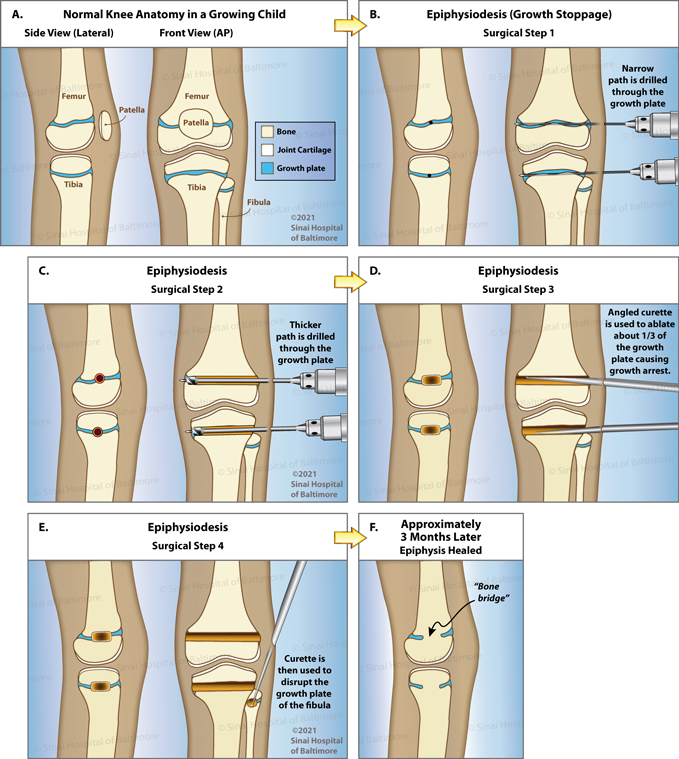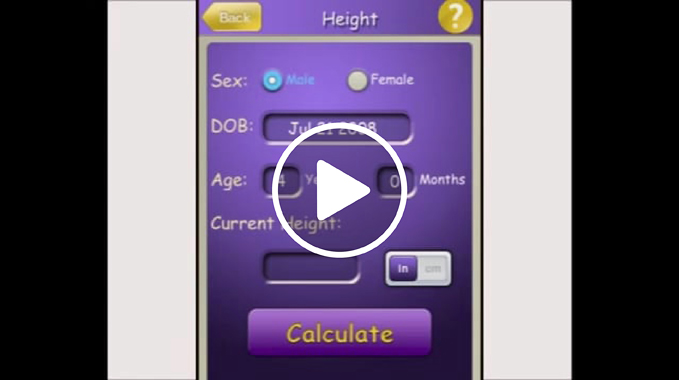Growth Plate Fusion (Epiphysiodesis)
What are growth plates?
Growth plates are responsible for bone growth in children. They are located near each end of the humerus (upper arm bone), ulna/radius (forearm), femur (thigh bone) and tibia/fibula (shin bones). The growth plate is a thin layer of cartilage (1/10 of an inch, ~3 mm) that is embedded in the ends of the bone. This growth plate cartilage is separate from the cartilage in the joints (knee, ankle, etc.).
What is growth plate fusion?
Growth plate fusion is a minimally invasive surgical procedure that slows or stops the growth of a bone. The procedure is done only in children, and growth can be slowed/stopped either temporarily or permanently. Growth plate fusion is also called epiphysiodesis.
When is growth plate fusion a good treatment option?
Growth plate fusion is an option when a child is projected to have a limb length discrepancy that will be between 2 and 6 cm (0.8-2.4 inches) at maturity. The growth plate fusion procedure is performed on the long/healthy leg. In some cases, stopping the growth is done in order to minimize the amount of lengthening required in the short leg. Ultimately, patients may not reach their tallest potential height after undergoing this process, but the legs will be of equal length.
Most bone growth in the legs happens near the knees, so the growth plates that are closest to the knee in the femur (thigh bone) or tibia (shin bone) are the ones that are typically fused. This stops/slows the growth of the long/healthy leg and gives the short leg the opportunity to “catch up” through natural growth or lengthening procedures so that the short leg eventually matches the length of the long leg.
Is the timing of growth plate fusion important?
The timing of a growth plate fusion procedure is very important. First, the surgeon must accurately predict what the child’s limb length discrepancy will be at maturity. This information is then used to calculate the best age to stop/slow the growth of the child’s healthy/long leg. The International Center for Limb Lengthening has developed the Multiplier app, which uses clinically validated formulae to predict a child’s limb length discrepancy at maturity and the ideal age for growth plate fusion to be performed. Watch this video to see the Multiplier app in action:
What happens during growth plate fusion surgery?
Typically, the child/adolescent is placed under general anesthesia for about an hour for this minimally invasive surgery. A 1-inch (2.5-cm) incision is made and the growth plate is fused. Temporary epiphysiodesis is accomplished with eight-Plates or percutanteous epiphysiodesis with transphyseal screws (PETS). Permanent epiphysiodesis is more common and is accomplished with surgical ablation (removal) of the growth plate using a percutaneous drill. Most patients do not need to stay in the hospital overnight after the procedure.
 Shown above are illustrations describing the growth plate fusion process known as epiphysiodesis. a. Normal Anatomy: Bones, joint cartilage, and growth plates are identified around the child’s knee in both the side view and the front view. b. Surgical Step 1: To stop the growth, a growth plate fusion is done through a small skin incision made at the level of the growth plate in the distal femur and/or proximal tibia. The first step is to insert a pin (with a drill) through the growth plate/s. c. Surgical Step 2: Next an 8-mm cannulated drill is passed through the growth plate/s. This removes a plug of growth plate. d. Surgical Step 3: An angled curette is used to remove additional growth plate to create a stoppage of growth in the child’s growth plate/s. It is enough to remove overall about one-third of the growth plate to stop growth in the entire growth plate. e. Surgical Step 4: Finally, the surgeon can use a curette to disrupt the growth plate in the proximal end of the fibula. f. Results: Approximately 3 months after surgery a “bone bridge” can be seen in the side view of the femur and tibia where the physis was disrupted. The slight residual intact growth plate (blue) is unable to grow in the face of a solid bone fusion in the central one-third of the bone.
Shown above are illustrations describing the growth plate fusion process known as epiphysiodesis. a. Normal Anatomy: Bones, joint cartilage, and growth plates are identified around the child’s knee in both the side view and the front view. b. Surgical Step 1: To stop the growth, a growth plate fusion is done through a small skin incision made at the level of the growth plate in the distal femur and/or proximal tibia. The first step is to insert a pin (with a drill) through the growth plate/s. c. Surgical Step 2: Next an 8-mm cannulated drill is passed through the growth plate/s. This removes a plug of growth plate. d. Surgical Step 3: An angled curette is used to remove additional growth plate to create a stoppage of growth in the child’s growth plate/s. It is enough to remove overall about one-third of the growth plate to stop growth in the entire growth plate. e. Surgical Step 4: Finally, the surgeon can use a curette to disrupt the growth plate in the proximal end of the fibula. f. Results: Approximately 3 months after surgery a “bone bridge” can be seen in the side view of the femur and tibia where the physis was disrupted. The slight residual intact growth plate (blue) is unable to grow in the face of a solid bone fusion in the central one-third of the bone.What happens after growth plate fusion surgery?
The patient will need to see the doctor 2 weeks after the procedure so that the doctor can check the incision and the knee’s range of motion. The patient is allowed to put weight on the leg immediately after surgery and will be able to return to normal activities within 2 to 3 weeks. Follow-up visits should happen on a regular basis (about every 4 months) so that the doctor can monitor the growth of the long leg as well as the short leg. Rarely, epiphysiodesis can cause the leg to grow crooked, so regular monitoring is advisable.

